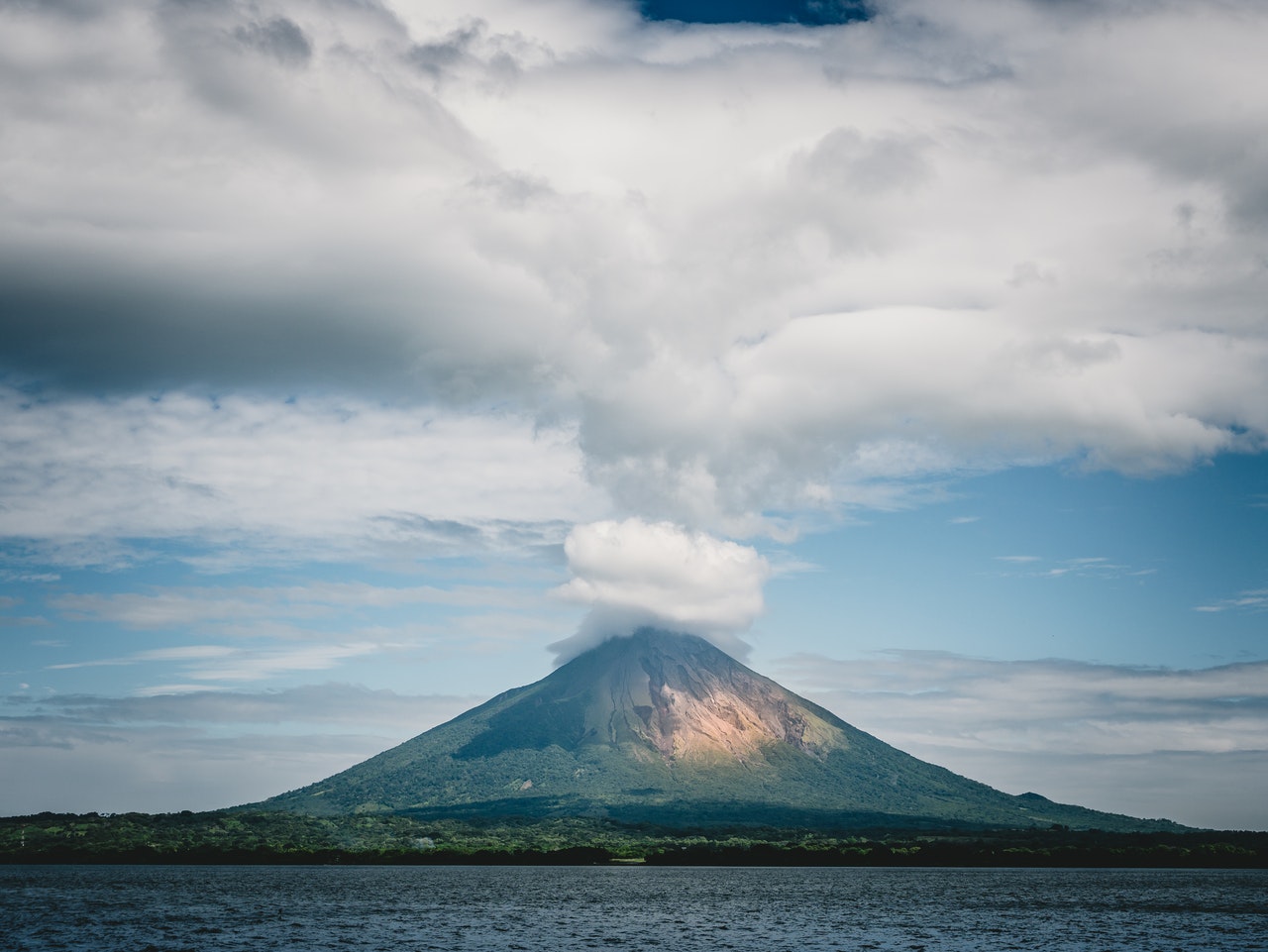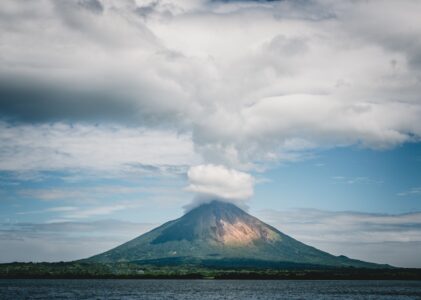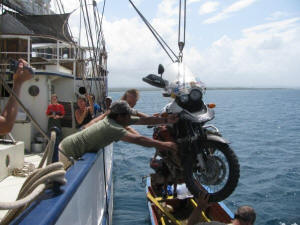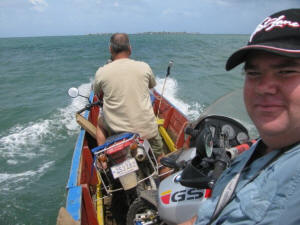Granada, Nicaragua
11 Februarie 2009
Ons is in Granada, Niciragua, ‘n pragtige koloniale stad op die oewers van die groot Niciragua Meer. Dis interesant hoe eenders, maar tog ook baie verskillend die lande van mekaar is hier in Sentraal Amerika. Honduras was nice, tropies, groen, maar die paaie is vrotterig en die mense ry soos die arabiere, onbeskof.
Al die Amerikaanse ‘junk-food’ resturante is ook daar. Niciragua in die anderkant het sover die beste paaie en ordentlikste
bestuurders buite die VSA, huise is netjieser en dorpe so bietjie skoner as hul bure in die noorde. Ook omtrent geen Amerikaanse winkels nie. Selfs die voertuie is minder Amerikaans, ons sien nou meer Toyota’s en ander kleiner voertuie. Langs die pad is ook groot komersiele plase, in plaas van die klein ‘ek-doen-my-eie-ding’ landerytjies. Ek sal later meer
uitbrei, wou maar net laat weet ons is veilig.
12 Februarie 2009
Nicaragua, ‘n land waarvan ek nooit tevore van gehoor het nie, het tot dusver die lekkerste paaie in Sentraal Amerika om op te ry, geen spoedwalle, ordentliike bestuurders en perfekte padoppervlak. Ons eerste stop was Esteli, ‘n netjiese Cowboy dorpie in ‘n bergagtige omgewing. Die deel van Sentraal Amerika kry sy reen in die somer, en is tans aan die droe kant. Vir die eerste keer in ‘n lang tyd sien ons groot komersiele plase, in pleks van die klein een-man landerytjies. In die plateland en klein dorpies is daar geen tekens oor van Nicaragua se grusame burger oorlog wat so 30 jaar gelede plaasgevind het die. Baie mense het in daardie tyd die uit die land gevlug en nie weer terug gekeer nie, daarom het dit die minste bevolkings getalle in Sentraal Amerika. Dit beteken ook dat daar aansienlik minder voertuie op die pad is wat die bestuur hier ‘n plesier maak. Dorpe is ook kleiner as die in die ander lande. Selfs die sogenaamde stede soos Matagalpa en Granada, is volgens my mening maar net dorpe. So gepraat van Matagalpa, dis die land se koffie-meca, en die omliggende heuwels is vol koffie plantasies. Die plant is amper ‘n klein boompie, so 1-1.5m hoog met donker groen blare en groen tot bloed rooi koffiebone die grote van Tumbels (Daai sjokelade lekkers wat jy by die huis kry) aan die boompie. Rooi is die kleur van die boon as hy ryp is en reg is vir pluk. Hulle word met die hand gepluk, een vir een en in sulke groot ‘veevoer’ sakke op vragmotors, trekkers en perdekarre vervoer. Ten spyte van hul koloniale en Spaanse oorsprong, is Nicaragua se dorpe nie so indrukwekkend soos die wat ons in Mexico gesien het nie. Nietemin is hulle netjies en ‘n ‘work-in-progress’. Granada is die mooste van die lot, en ook vol toeriste, wat nie altyd ‘n slegte ding is nie, maar dit stoot die verblyf pryse op en maak dat baie locals op toeriste staatmaak vir ‘n inkomste, en dus jou nie met rus laat nie, wil altyd iets aan jou verkoop of net sommer plein weg bedel. Ek wens toeriste wil besef dat dit eintlik skade doen om vir bedelaars net geld te gee. Inteendeel het ek geleer dat dit dinge moeilik maak vir toeriste in die toekoms.
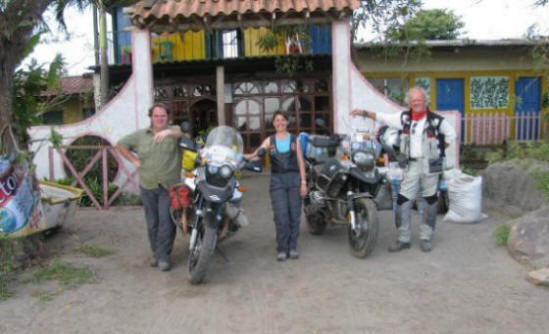
Gaan toer maar gerus deur Afrika en jy sal sien wat ek bedoel, veral Etehopie, waar jy baie keer met klippe bestook word as jy nie geld wil gee nie. Granada is darem nie so erg nie, en ons is ook al gewoond daaraan en ignoreer die paar bedelaars en smouse wat stofvergaderaars aan ons wil verkoop. Dis ook bietjie aan die warm kant hier, en vir die eerste keer sedert ons die Midde Ooste verlaat het het ons 40 grade C op die meter gesien. Ja, ons beweeg al nader aan die ekwator. Vandag is dit wasgoed dag en inhaal met die dagboek, so tussen-in sal ons die dorp se interesante koloniale strate en mark verken.
15 February 2009
We are heading for the Costa Rica border today. It has been fantastic in Nicaragua!
Costa Rica
17 February 2009
We are in San Jose, Costa Rica. Had an awful border crossing yesterday between Nicaragua and Costa Rica, more than 5 hours! Tomorrow we will find out whether we can go to Panama or not, and how we will get to Colombia. We will see.

Good News & Bad News
19 February 2009
We are on the way again. Have good news and bad news. Got the Panama visa today! Some bastard stole my compressor and first aid kit off the bike, (It was locked on) behind ‘locked’ doors of the garage of the hostel. The staff doesn’t seemed to be fazed and and just pull up their shoulders. I’ll make sure bikers know not to support this hostel again. Give Hostel El Chante in San Jose a miss, despite of the ‘secure’ looking garage.
So we’re not sure where we will be ending up tonight, and should cross into the long awaited Panama tomorrow. Costa Rica is nothing to rave about. We made contact with Karl in Bogota and they are looking forward to meet up with us, so we have lots to look forward to in Colombia. Bring it on!!
Costa Rica Border
21 February 2009
We have just had a major 900km run around, from one border in the north of Costa Rica to the other one in the south, rode right through the night in soaking rain. All because they would not exit stamp my RSA passport.Eventough I would be using my German passport to enter Panama. We had no problem at the border in the south. Just waiting for clearance for the GS. Praise the Lord we are on our way! We are in David Panama, we have done 1050km since yesterday morning, lots of time wasted at the borders……..going to sleep for two hours and then will go and look for food.
Trujillo, Honduras to San Jose, Costa Rica
22 February 2009
We had a relaxing time at Casa Kiwi, Trujillo, Honduras waiting for the rain to stop. It was the first time in a long time that we had real healthy salad and good home cooked food, thanks Chaz. The normally beautiful Caribbean Sea was a nice brown colour from all the muddy rain water coming down all the rivers but at least we could watch the iguanas on the big pile of wood from our bedroom window. The road south was really bad in one section potholes and gravel for over 100 km’s and some of it was first gear stuff. We did a ‘long’ short-cut around Lake Yajoa through some of the most amazing mountain roads –-single track stuff – and eventually found our way to the village of Las Vegas.
The border crossing from Honduras into Nicaragua was pretty uneventful, it was not long (about an hour and a half) and we were on the road in Nicaragua. There was a noticeable difference in the quality of the road surface, it was smooth with a new tar surface and had no speed bumps! It wound down the mountain through a beautiful valley filled with trees covered in beautiful big orange blossoms. What a gorgeous sight to greet a new guest to a country. We also noted the lack of American franchises that we had seen all over Honduras. The terrain changed to thorn trees, cactus and long grass, much dryer conditions and no more humidity. The one section of road before Ginotega was beautiful – the road surface fantastic with many twist and turns – the GS was in her element and Johan was loving it. We then went on the old road to Matagalpa which was also in the beautiful mountains but it was in desperate need of repair. This was the only section of bad road in Nicaragua. The town of Granada reminded us of Alomos in Mexico, beautiful laid out cobbled streets and colourful colonial homes and buildings with courtyards.
We decided to go to Isla de Ometepe, one of the islands in Lake Nicaragua. While waiting for the ferry in San Jorge we got chatting with another RTW traveler, Peter Maddox an Australian on the 1200GS. The ferry was interesting – it could only hold one truck, four pickups and our two motorbikes! The crossing was a little bumpy as there was a lot of wind & choppy but we were chatting so much that we hardly noticed it. The first section of the road around the big volcano on Ometepe was brick paving but the other section was one of the worst roads we have ever been on – rocky, sandy and everything in – between! We found a nice place to stay in on the wind – ward side of the island which was a blessing because as soon as you were out of the wind it was very hot! It was fascinating watching the clouds swirl around the top of the volcanic mountain, as if the water particles were attracted to the top like a magnet! We had a wonderful time on Ometepe with Peter and ate the biggest Tilapia we have ever had. Thank you Jesus.
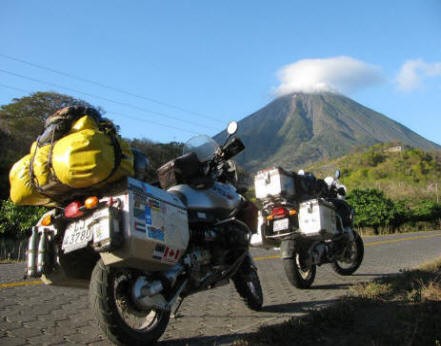
We had our worst border crossing ever from Nicaragua to Costa Rica – five and a half hours! Every time we thought we had everything done to get out of Nicaragua, the guy at the final gate would send us back saying that we had to get another stamp on our little piece of paper….. what to do! And the queues, they were miles long! It looked like every tourist bus in the country was there, there were people everywhere, some arriving and others leaving. Then on the Costa Rica side it was the same thing, queues a mile long and lots of paper work. At the final checkpoint we were told that we still had to go to the main customs office which was half way back to the first customs office we were at…. yet another queue and then eventually we had all the paper work, phew – it was quite tiring. The north of Costa Rica is dry and hot and reminds us of South Africa; even the houses have burglar bars and security gates! For such a developed country the roads are pretty bad – single lane traffic mountain passes which is quite silly seeing that it is the main Pan – American Highway. The trucks caused huge tail backs and we had to sit at first gear speeds until there was a clear straight to power past the trucks. We were surprised how much cooler it was in San Jose and it has been very windy, just like Somerset West and the Strand in Cape Town. The city is developed and quite modern, a lot like South African cities. We are now waiting for the authorization from Panama to put the already approved visa into the passports.
Panama
22 February 2009
This might be the last internet or contact that we will have for a while. We slept last night in a Hostel on the outskirts of Panama City. Today we will be buying tyres and service parts for the bike, fit and service it tonight, and then drive to Carti on the Caribean Coast tomorrow to board the sailing boat we will be taken to Colombia. It is a big old German boat called Stahlratte, (www.stahlratte.com) and is well known for this crossing.
They charge us about $1200, compared to flying that would cost aboat $1500. Not much different, but we will arrive in Cartagena instead of Bogota, so will be able to see more of Colombia too. We were told that the road up to Carti (and the San Blas islands) is through thick Jungle, 4×4 stuff. The loading of the bike will also be interesting, from the dock to a motorised canoo to the sailing boat, we will see. Crosing takes 3 or 4 days, and we will stop over on some little islands on the way for snorkeling and swimming. We drove over the big Canal yesterday, what a site! Would have loved to see more of Panama, but the boat is not waiting for no-one.
25 February 2009
Praise the Lord all is fine. Very rough roads to Carti. One river crossing and then a motorised canoe to the boat anchored off Carti Suitupo.We will stick to the Pan American Highway Cartenena, Medelen, Bogota, Cali, Quito.The boat leaves today for a island, we will snorkel swim and have a braai.
Columbia
28 February 2009
Praise the Lord for a safe voyage. Yesterday real rough this morning it is ok. Now we are anchored in Port Cartagena, waiting on board for immigration clearance. Johan and James are busy with customs and I am looking after the bikes in the drizzle, thankfully it is warm. We have heard that the customs could take all day. Thankfully James is good with spanish,so there wont be messing around!
Cartagena, Colombia
2 March 2009
We went walk about yesterday, nice but not as pretty and clean as Mexico. James has been here before and says the other towns are nicer than Cartegena.
4 March 2009
Yesterday we drove from Cartegena to Planeta Rica. Today we will ride to Medellin. Talk about slow we only got the bike papers from customs at 5.15pm.
San Jose to Cartagena
5 March 2009
We enjoyed San Jose, and walked around the city centre looking at the beautiful crafts and ate good cheap pizza. For the first time we saw paintings done on bird feathers, which seems to be everywhere for sale in Costa Rica. They really are pretty, but quite expensive, as it must be a fine art to paint it. Eventually, after 3 days in San Jose we got the long awaited visa for Panama, just in time, as we discovered items stolen from the bike in the hostel’s ‘secure’ locked garage on the third morning.. We were furious and confronted the hostel staff, as it seems that they never locked the gate that night. They just shoved up their shoulders and basically said that it is not their responsibility or problem. So we decided to leave the hostel and city immediately. We drove up the Irazu Volcano, a huge volcanic mountain where the roads leads up to the crater. We spent the night in cold weather at almost 3000m above sea level. The next morning it was cloudy and raining, and we could not see the crater, and drove all the way to the Panamanian border on the Caribbean Coast, in hopes to get out of Costa Rica.
All day we drove in the rain and could not take any pictures of this beautiful part of the country. We arrived late afternoon, and were turned away by the border officials. They were just plain unfriendly, and not willing to let us through, due to some visa confusion on their side. We were told to come back the next day, with a ‘tip’ and then they ‘might’ be able to ‘fix’ the ‘problem’. The town was a dump, and everything was deep in the mud, and we did not want to spend a night there, so decided to rather drive to another border. It took us all night long to get to the main border on the Pan American highway. Most of the driving was in heavy rain, with poor visibility, but the concentration required kept us awake. At about 2 in the morning as we came over a clear and cloudless summit we could see the Southern Cross right in front of us. It was about 4-5 years ago when we saw it the last time, and it had a special meaning to us, almost like a home coming, we are almost back in the Southern Hemisphere. We arrived at the border by sunrise, and had to stand in a long queue full of bus tourists.
There we met Martin, an American on his V-Strom. He told us that everything in the country (Panama) was closed for the week of Carnival, and freight companies will not be able to fly our bike to Colombia. That evening in David I checked the internet for an alternative way to Colombia, and came across the Stahlratte, a German boat that transports passengers and motorcycles between Panama and Colombia. It was quite a bit cheaper than flying, and we booked our place on this boat, a decision we will never regret, as it was a trip of a lifetime, but more about that later. For those who do not know, there are no roads between the two countries, it is thick jungle and is called the Darien Gap. Panama is in many ways American, the roads, the towns and even the money. We enjoyed our few days in Panama and briefly saw the biggest engineering marvel in the world, the Panama Canal.
In Panama City we stayed with a friend of Charmaine’s cousin, Jacx and Nigel, who have been living there for two years. Through Horizons Unlimited’s HUBB we met up with James, who was also booked on the Stahlratte voyage to Colombia. James is an American riding a 250 Honda down to Argentina. We met each other on the outskirts of town at 7 in the morning to ride out together to Carti. The road to Carti is notorious for being very rough, and I was not looking forward in doing it. Just before the turnoff from the main road, we ate our last meal in Panama and set off on the slippery (wet) muddy road. It was slow going and with extremely steep inclines over the mountains. The GS handled it very well, as there is no lack of power in the 1150cc motor, but traction was another thing with the smooth rear tire on the slippery mud. There was one river crossing that was not too bad, although a bit deep. The GS’s cylinder heads was under water for a short section, but she made it through without any problems. I’m starting to really like my GS again, as the problems it had in the USA is now in the distant past.
We arrived at the end of the road, and loaded the bikes into a wooden canoe, a scary thought by itself. It was clear that the local Kuna Indians have done this before, as they loaded the heavy bike into the rocking canoe like pros. It was a 5 to 10 min ride through the open water to get to the anchorage point of the Stahlratte. Ludwig (The captain) and his crew used a crane to load both bikes safely on the deck, and covered the bikes nicely. Again, it was clear that they have loaded and transported 100’s of bikes in the past. One of the crew members, Rolli from Austria, looks and sound just like Arnold Swatzenegar. He also was on a major world tour with his BMW R100GS, and somehow ended up on the Stahlratte as part of the crew for the last two years. He told us all sorts of interesting stories about his travels in South America. The rest of the 16 passengers arrived the next day, and then we set sails to one of the uninhabited San Blass islands, where we anchored and spent the evening and had a BBQ on the beach. The next day we sailed to another group of Islands for the next night, and what a beautiful spot this was! It was a group of islands that is so close that you can swim across from one to the next. Bright clear turquoise water, white sand beach with bright green coconut trees was our background picture that evening. Our fellow passengers were a very nice group of people, mostly young backpackers from different European countries. The next morning we set sails again for our longest stretch of water across the depths of the Caribbean Sea. The swells were big and the boat was rocking a lot. Everybody except the crew was sick and laid flat on our backs for at least the first 10 hours. Half of us sort of recovered and could face some food later on while the rest only ate the next morning when we were close to land again. The captain and his crew were a jolly bunch and help made the journey very enjoyable. As we came into Cartagena, I started to worry again about the off loading process. Like with the loading, we transferred the bikes from the sail boat to a small rubberduck, motored about two minutes across the water to the dock and man handled the big GS off the rubberduck and up onto the wooden jetty. It was a huge relief for me when we were all loaded up and drove into town to the Hostel. South America is our 5th continent and is the one we’ve been looking forward the most.
